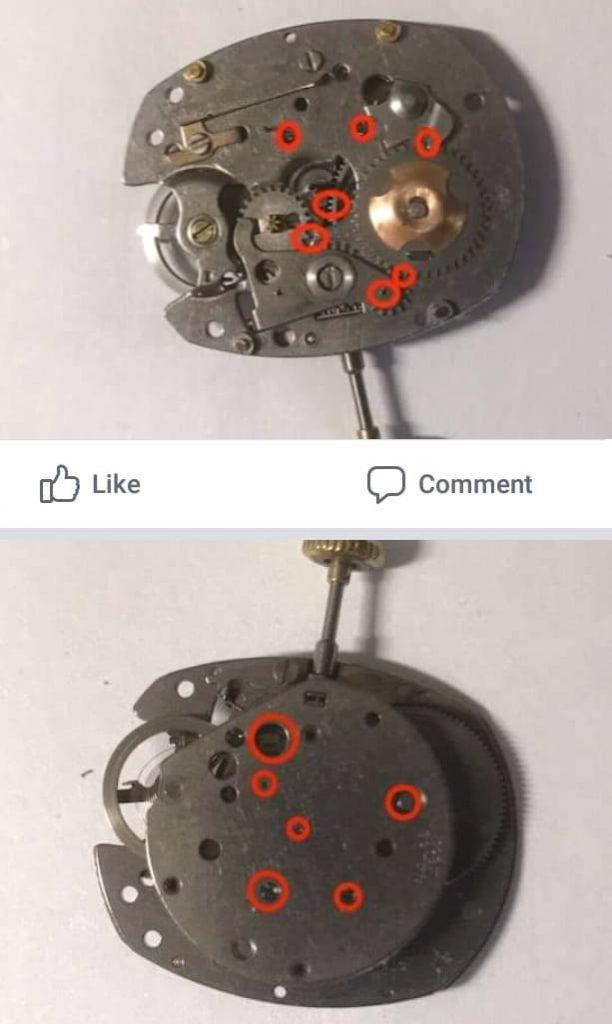WARNING: Try this at your own risk
This guide is designed to take you through servicing vintage Timex watches from 1961 through to the early 1980s using movements m24 to m108. Watches before this period use full brass movements and can be serviced in a similar manner with a few, but significant differences.
Table of contents:
Watch servicing tools and equipment
To start servicing a vintage Timex watch movement you will need the following tools:
- Demagnetizer
- Spring bar tool
- Case back opener/knife (you can in some cases just use a screwdriver)
- Watch repair screwdriver
- Case cushion (optional)
- Crystal lift
- Hand removal tool/ Hand removal picks
- Finger cotts (optional)
- Movement holder (optional)
- Tweesers
- Citrus de-greaser and isopropyl alcohol
- Paper towels or hair dryer
- Oilers
- Moebius 8000 Oil
- Grease
- Rodico
- Hand pressing tool
Triage
Before attempting a Timex watch service I first triage the watch to try and determine how involved the service would be. Often it is a simple matter of cleaning the partially disassembled movement by dipping it in naphtha or isopropyl alcohol (or both) and oiling pivot points to bring a piece back to life. See our Basic Watch Service guide for this process
1. Try and wind the watch
- Is the watch crown stuck and will not wind? This likely means the watch needs a basic service.
- Is the watch stiff to wind? Again a basic service is likely needed.
- Does the watch partially wind then go “zip” and unwind? This is likely an issue with the Click or Main Spring.
- Do automatics wind with a shake?
- Is the automatic winding rotor still attached or is it rattling around in the case?
2. Try and set the time and date
- Is the crown and stem secure or does it come out or break apart? Is a new crown and stem required or is the crown simply not inserted correctly?
- Does the minute and hour hand turn without clashing? Resetting the hands could free the movement.
- Does the date change and is the date wheel misaligned?
3. Give it a vigorous shake
Some times this is enough to start them, does it continue ticking, or does it stop after a few minutes or hours?
4. The litmus test
My litmus test process was given to me by @thetimexking so a massive thanks to him.
Demagnetize the watch
Open the case back to expose the movement.
Using an oiler, add oil to the pivot point above the hole for the pallet fork.
Add oil to the pallet fork pivot.
Poke your oiler through the hole for the pallet fork and give the pallet fork a flick.
50% of the time the watch will spring to life. It may not work consistently or keep good time for a full day, but is a good sign that the watch just needs a clean. Any other outcome and then you may need to break the movement apart and check all pivot points, balance wheel and wheel alignment.
Basic Watch Service
Below is a video by Buckminster Watches where he services an M24 no-date Timex watch. Warning he misses some pretty big steps out and incorrectly removes the minute hand however, it is a good basic introduction.
If you’re interested in servicing an older pre 1961 Timex then the following is a good example however he goes full tear down to the actual gears which may not be required.
1. Remove the crystal
See the crystal removal guide.
Remove the second hand (M2x) or all hands (M1xx)
See our hand removal guide.
Remove the case back
See our case back removal guide.
Remove the crown
See our crown removal guide
Now take the movement out of the case
Remove the dial
On a majority of movements the dial is held on by 3 dial feet. These are small tabs that poke through holes on the movements top plate and are bent over to secure the dial in place. As a result these can be brittle and can get fatigue causing them to break off if they are over used.
To remove the dial simply push the tip of a screwdriver between the tab and the plate. Now lever the feet upwards so they sit at a 90 degree angle to the dial. This allows them to be more easily put back into placer.
The dial should now come off. If its not moving, reassess your dial feet and gently lever the dial off. Put this under a bell jar or in a dust free container to keep it clean.
Let down the mainspring
If the watch is wound tight then you will have to release the tension in the main spring. This allows the cleaning solution to better penetrate and clean gunk that is sticking the coils of this spring together.
Insert the crown back into the movement and secure it. This will be used to stop the main spring from becoming fully unwound too fast which could damage it. You will need to use your fingers as a break to slowly let the spring down… but we’ll come to that later. For now keep a good firm grip on it.
To let down the main spring you need to release the “click” which is a small component that stops the mechanism from becoming unwound. It can be found on the dial side of the movement.
To release the click you’ll need about 12 arms LOL. One to hold the movement, one to hold the crown and one to release the click. Keep a firm hold of the crown and add tension to move the click into an extended position. This allows the click to be moved without it clashing with the mechanism. Next use your thumb to push the click backwards allowing the main spring to unwind. Using your finger as a break, slowly let the crown spin in your fingers. This reflects the unwound state of the main spring. When the crown stops moving release it.
Loosen the balance wheel
Give the balance wheel pivot screw 1/2 a turn to release tension and give space for cleaning fluid to remove any debris.
Remove rocking bar
Next 3 tips by @thetimexking
Unscrew the rocking bar and save these parts for cleaning separately to the case.
Remove canon pinion
Using tweezers, pull the canon pinion out of the movement
Split canon pinion
This component typically causes resistance when winding a watch.
Once split save these parts for cleaning separately to the case
Clean movement parts
Depending on your budget there are two methods you can use to clean a watch movement.
Ultrasonic method.
Fill the tank of your ultrasonic cleaner 75% full with water.
Put the movement into a glass beaker and cover with your cleaning solution. Many people use Ronsonol lighter fluid (naptha) to clean and de-grease the movement. A more aggressive cleaner is Isopropyl Alcohol which cleans more thoroughly but dries slower and may need a short blast by a warm hairdryer to remove any remnants of fluid.
In a second beaker place the additionally removed screws rocking bar and and canon pinion components.
Give it a blast in the ultrasonic.
Repeat this process exchanging the dirty fluid for fresh until the fluid remains clean.
Leave the movement to dry (naptha) or use a hair dryer to evaporate the isopropyl alcohol. and place in a dust free container.
Swish method
Place the watch movement into a small container. I find mini jam jar pots work well. And cover the movement in your cleaning solution. Now gently swish the movement around in the fluid for 5 minutes. You should be able to see debris fall from the movement.
Do the same for separately cleaned components
Repeat this process exchanging the dirty fluid for fresh until the fluid remains clean.
Leave the movement to dry (naptha) or use a hair dryer to evaporate the isopropyl alcohol. and place in a dust free container.
Reassemble the movement
Combine the canon pinion and insert into the movement.
Reattach the rocking bar.
Tighten the balance wheel pivot screw 1/2 a turn
Oil the movement
Read about this in the oiling guide below
Reassemble the watch
Add the dial back onto the watch. This can be tricky as you have to not only get the dial feet into the holes in the top plate but also the center hub for the hands. I suggest seating one of the dial feet into the top plate first and pivoting until the other 3 components find their way home. You can also align the hub with the dial and rotate until the dial feet slot in. Now bend the dial feet to secure the watch dial.
Put the hands back on and check they turn without clashing. Give it a shake and make sure they stay in place.
Remove the crown.
Add the crystal back onto the case and insert the complete movement and dial assembly.
Align the movement so the crown can be reinserted and attach the crown.
Put the case back on.
Check all watch functions. Does it wind and set?
Demagnetize the watch
Time your watch and calibrate it.
Fit a strap
A full Timex watch service
Source: http://www.orologiko.it/forum/viewtopic.php?t=8926 User: mat939– Translated from Italian with help from Google Translate
WARNING: Try this at your own risk
We begin to remove the strap and align the spheres to facilitate their extraction. I usually do this alignment immediately, before removing the winding shaft (which otherwise has to be reinserted after removing the movement from the case) but of course it makes sense if the movement is stationary (this is nailed despite the spring being fully loaded) and it does not even start again “a little bit” (which often happens, even with the spring unloaded!).

Now let’s remove the caseback using the special notch (very very evident) and discover the inside. Then we remove the “dress” indicated by the red arrow which serves, with the caseback closed, to keep the movement still:

And here we begin to glimpse our “client”. Let’s now free the winding shaft by unscrewing the screw indicated by the red arrow and then removing the stop indicated by the yellow arrow:
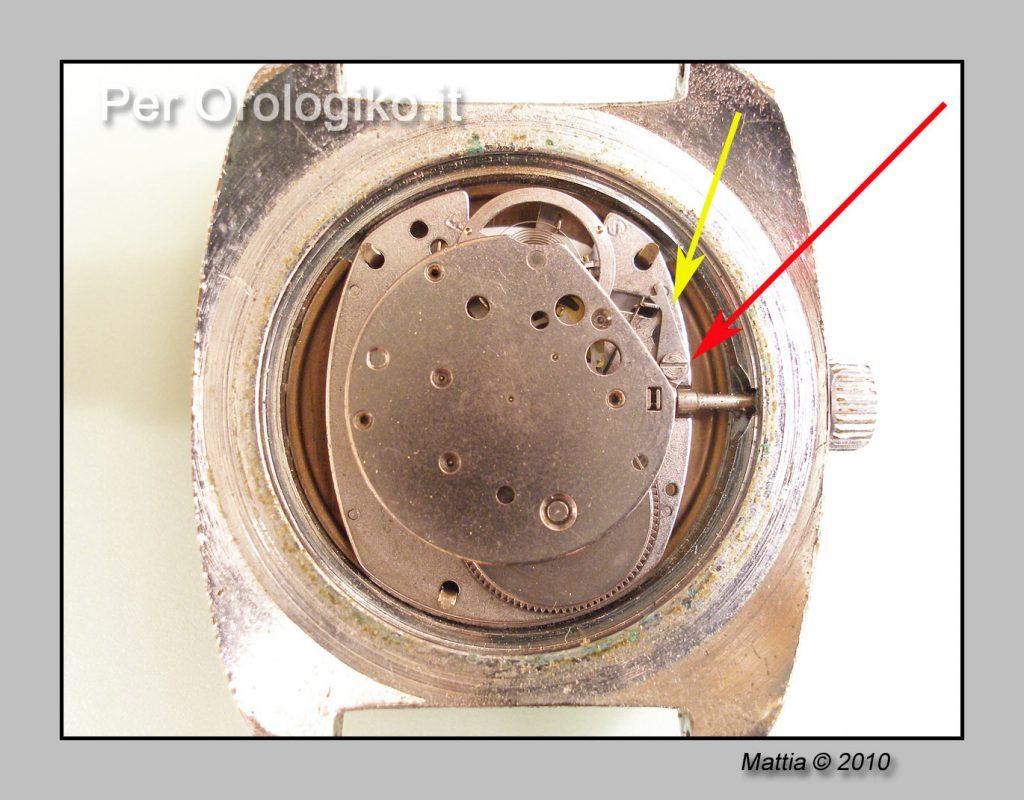
Let’s extract the winding shaft:

The movement comes out on the back side, so now it’s enough, after placing your hand to plug the open bottom of the watch … turn everything to find the movement (with attached dial) in your hand. Do you want to be a perfectionist and not touch the movement with your hands for any reason in the world (but then it must be washed anyway)? Put a card on the open back of the watch and turn … the movement will obviously remain on the card!
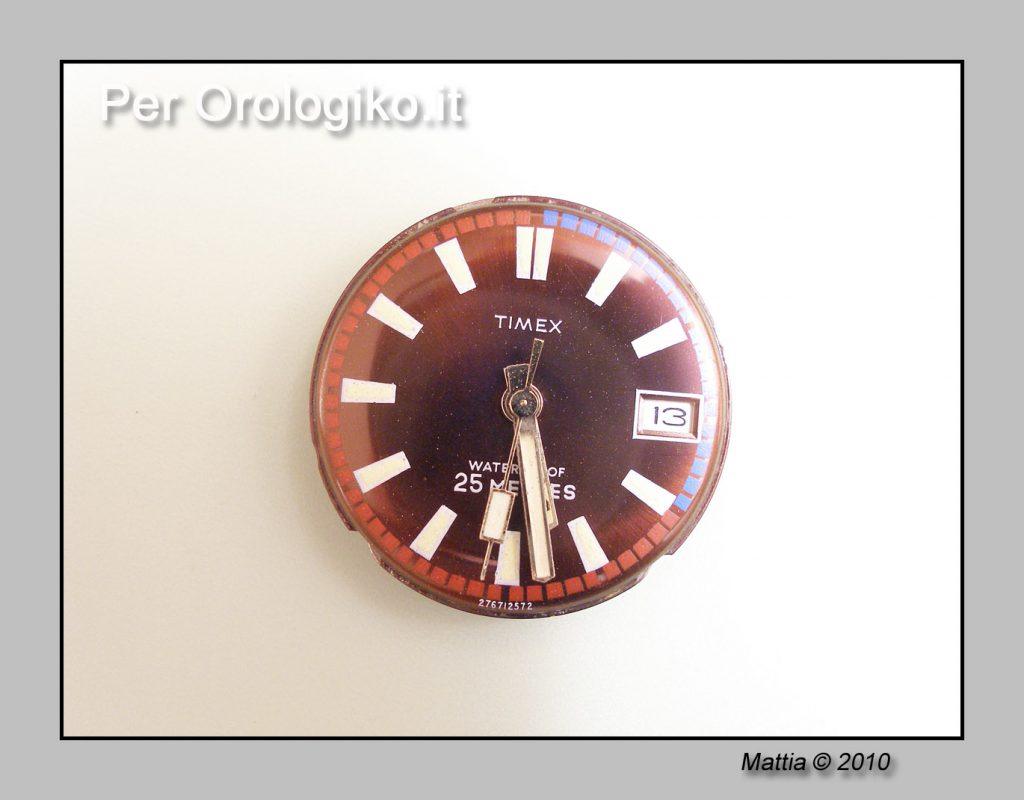
Have you noticed the numbers printed below? They are one of those things who but immediately make a watch or a brand of watches (as in this case) likeable. In fact, the final number 72 means that the watch was produced in 1972 while the 25 written before is the movement number (in fact it is an M25). The first five digits should be the catalog model number. It is not easy? And here is the orba case of the movement:
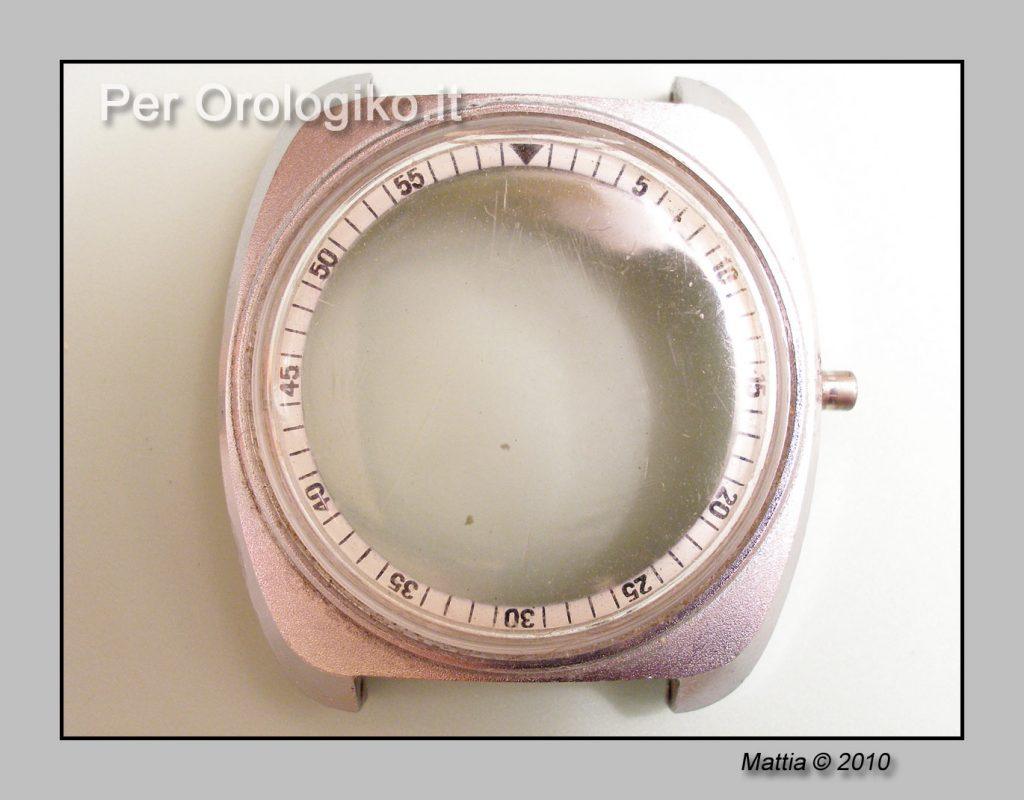
Now let’s put the movement on a movement holder and with a spheres lever, protecting the dial, we remove the spheres:
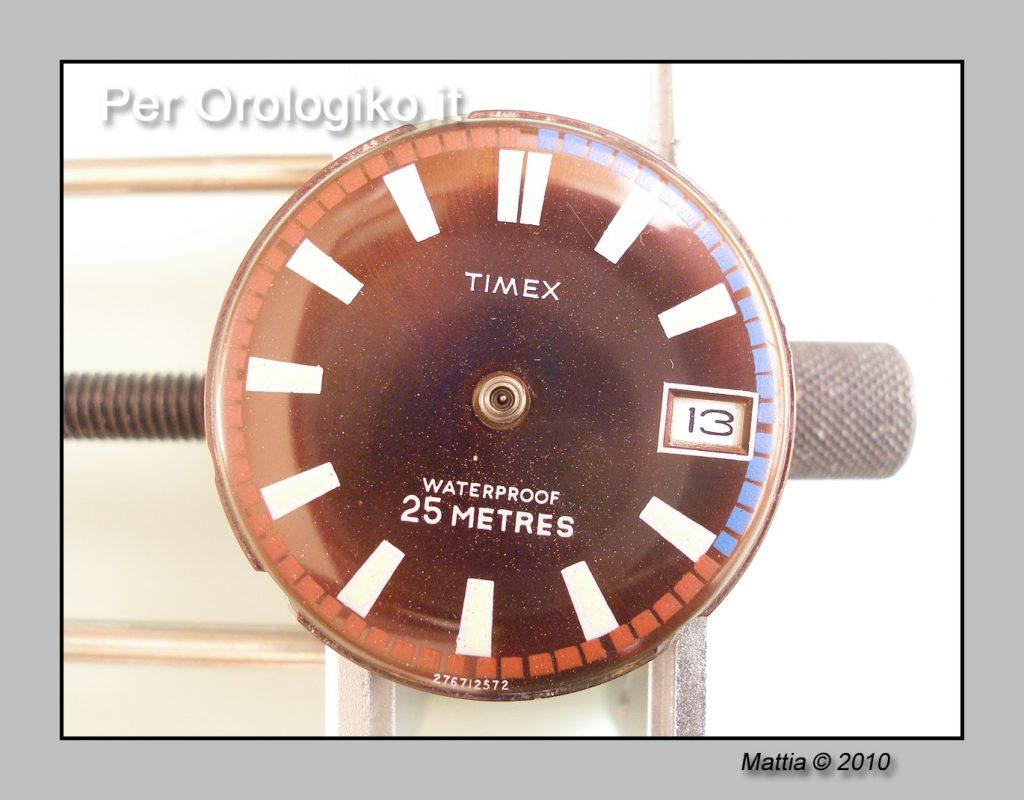
We must now remove the dial. In a traditional watch it is usually possible to remove it by leaving the movement on the movement holder, but in this case it must be removed to “explain” the wings (indicated by the red arrows) that fix it to the dial. Of course, calm and kindness are needed. Two of the tabs must be fully open (made perpendicular to the dial) while the remaining can be kept semi-closed.

And here’s what we find under the dial. Note the pin on the wheel that triggers the date (red arrow) and the scattadata (yellow arrow). The date disc turns against the four columns placed at the edges of the disc and is stopped on the dial side… on the dial!
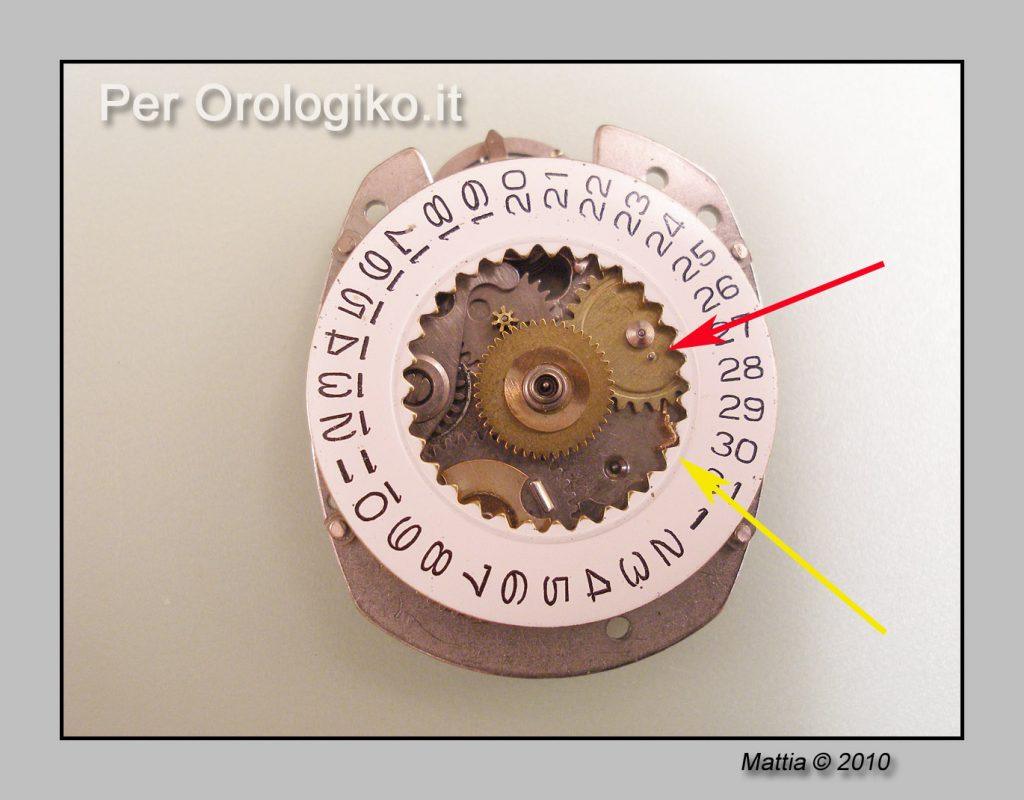
I love the hour wheel and the pinion below:
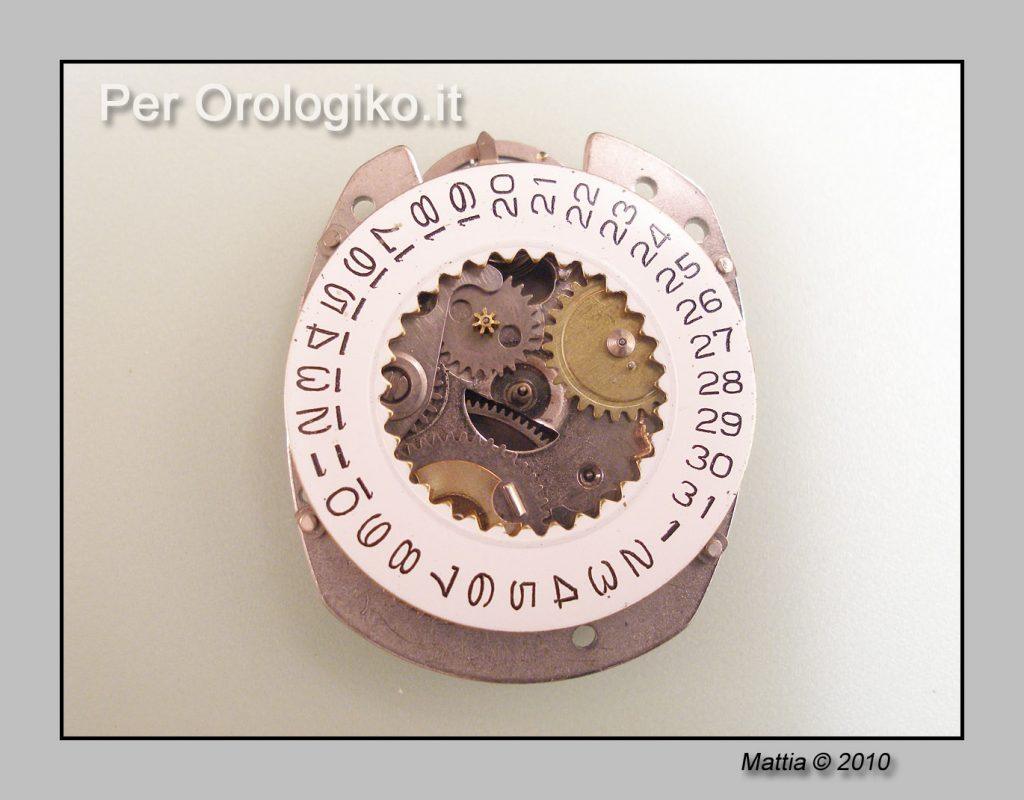
We remove the data disc:
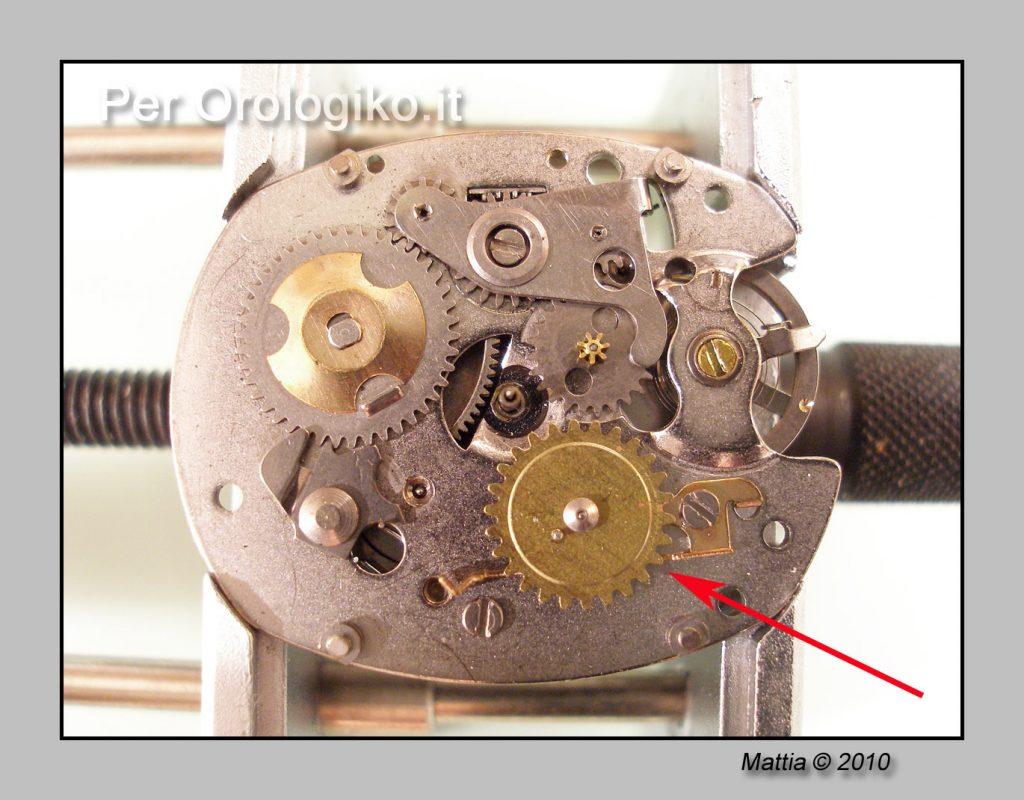
We remove the wheel indicated by the arrow and we get this:

At this point it is necessary to unload the spring. To do this you need to reinsert the winding shaft (red arrow, just insert it … it is not held by anything but it works anyway) and turn as if to load. The ratchet (indicated by the yellow arrow) will move and we will keep it apart so that it does not “ratchet” using some tool (possibly a “soft” tool such as a boxwood stick, so as not to scratch the sinker) and at the same time we will gently unload the spring letting the crown turn between your fingers.

We remove the screw indicated by the arrow and remove the dancer. This screw not only holds the dancer but is one of the three screws that hold the two plates together.
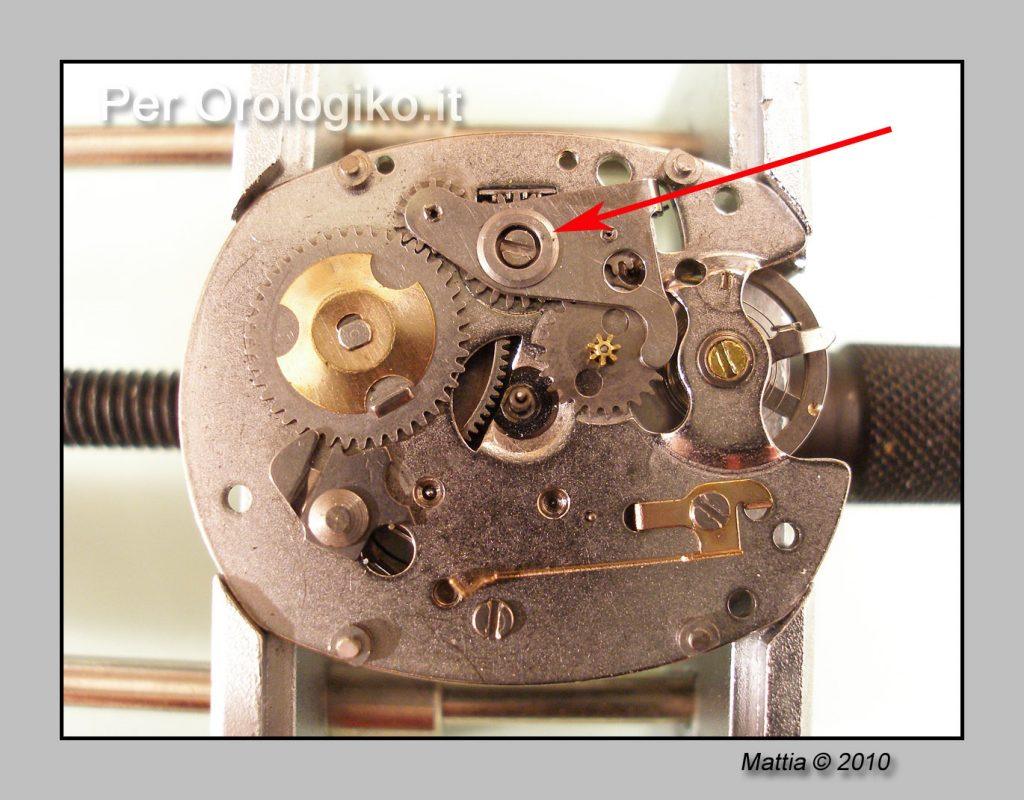
The two wheels on the sides (indicated by the red arrows) are identical so you can easily swap them.

Here it is without the dancer and the wheels. We also remove the scattadata held by the screw indicated by the arrow (it is the second of the three screws that hold the two plates together):

Now you need to remove the barrel stop. Using a screwdriver, gently lift the golden cotter pin (red arrow) in correspondence with the notch on the wheel (yellow arrow). At the same time we turn the cotter pin a little until it exceeds the notch (the sense is indifferent).
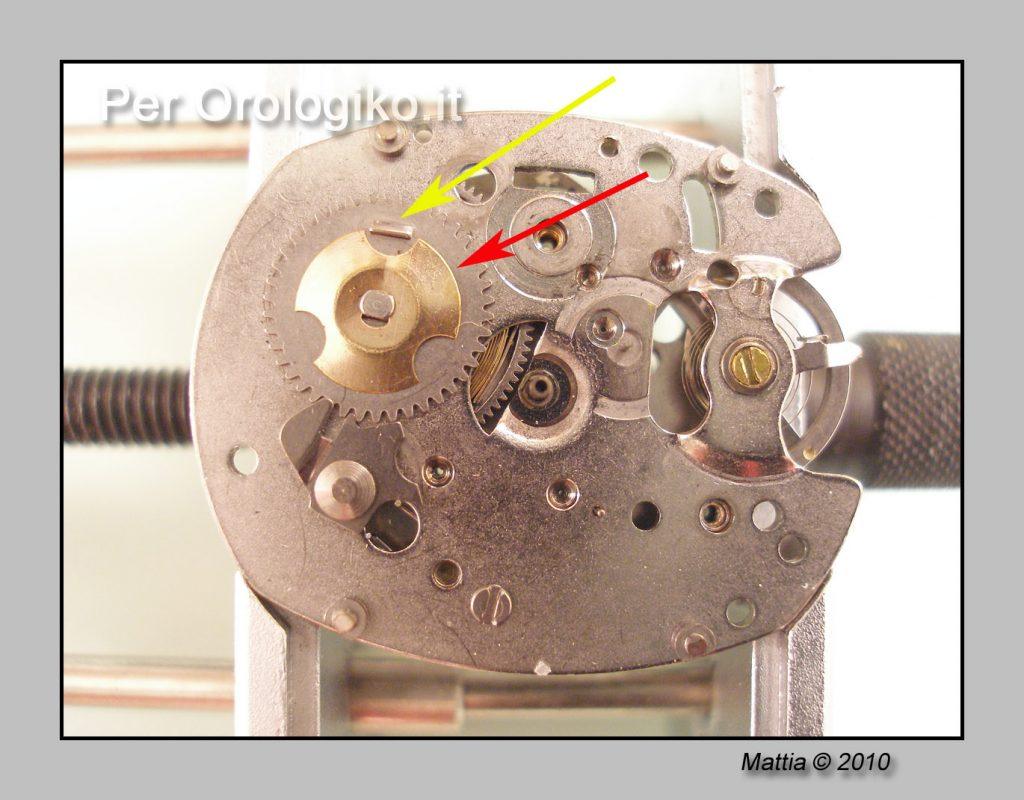
We turn the cotter pin until the elliptical hole on it does not correspond to the shape of the barrel axis. At this point the cotter pin comes off:

Via also the wheel:
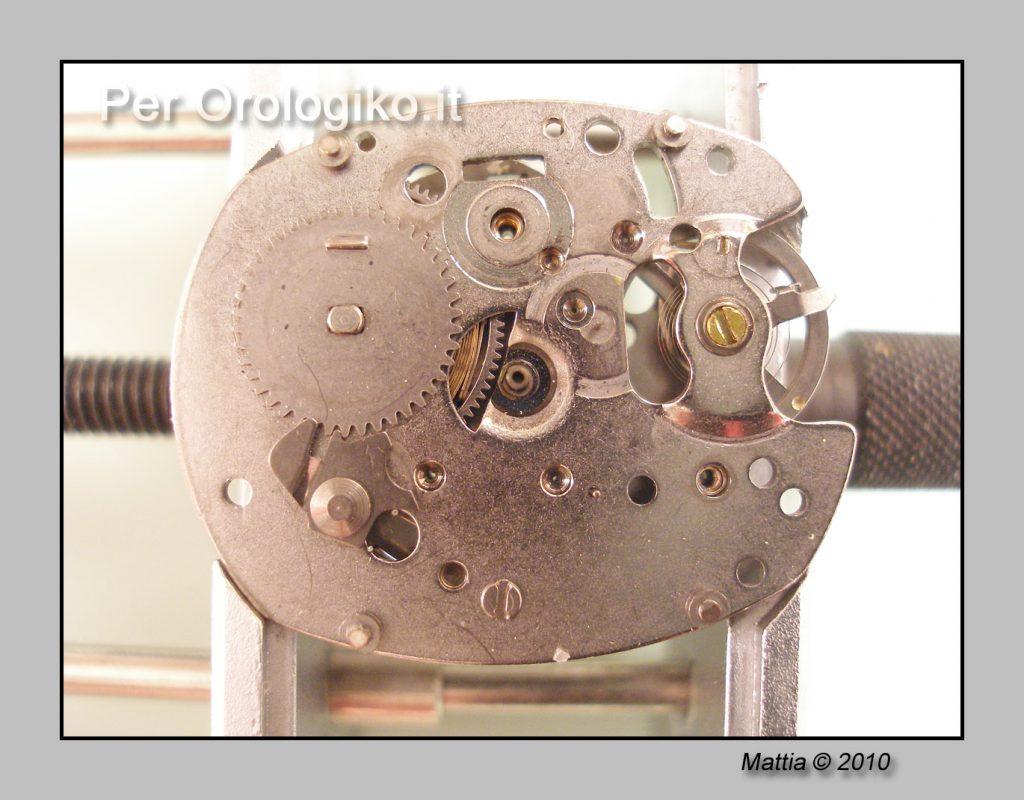
At this point the two plates that enclose the heart of our watch are held only by the screw indicated by the red arrow:
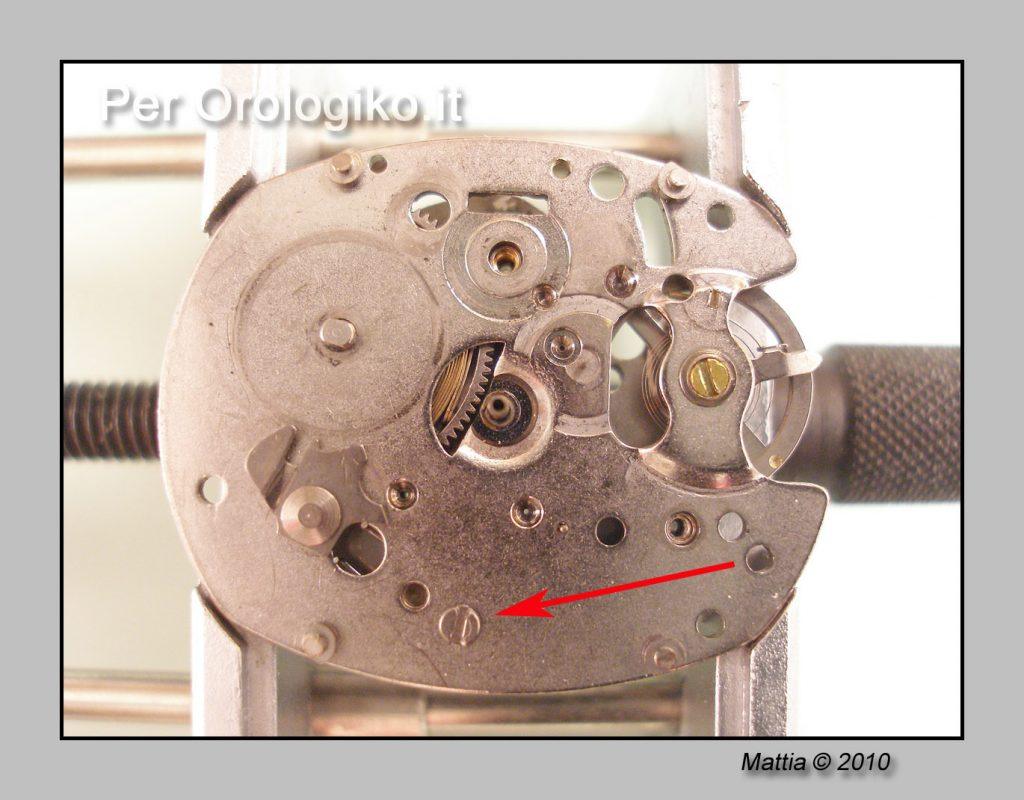
STOP !!! You haven’t already removed it … with all that comes with it (pieces scattered all over the table and on the floor !!) !? Remove the movement from the movement holder and holding the two plates gently closed with the fingers of one hand (clean fingers and with immaculate and short nails … De Carle would say by placing a piece of silk paper between the movement and your hands), unscrew the offending vine with the other hand. Now gently place the movement on the movement holder upside down from how it was before:
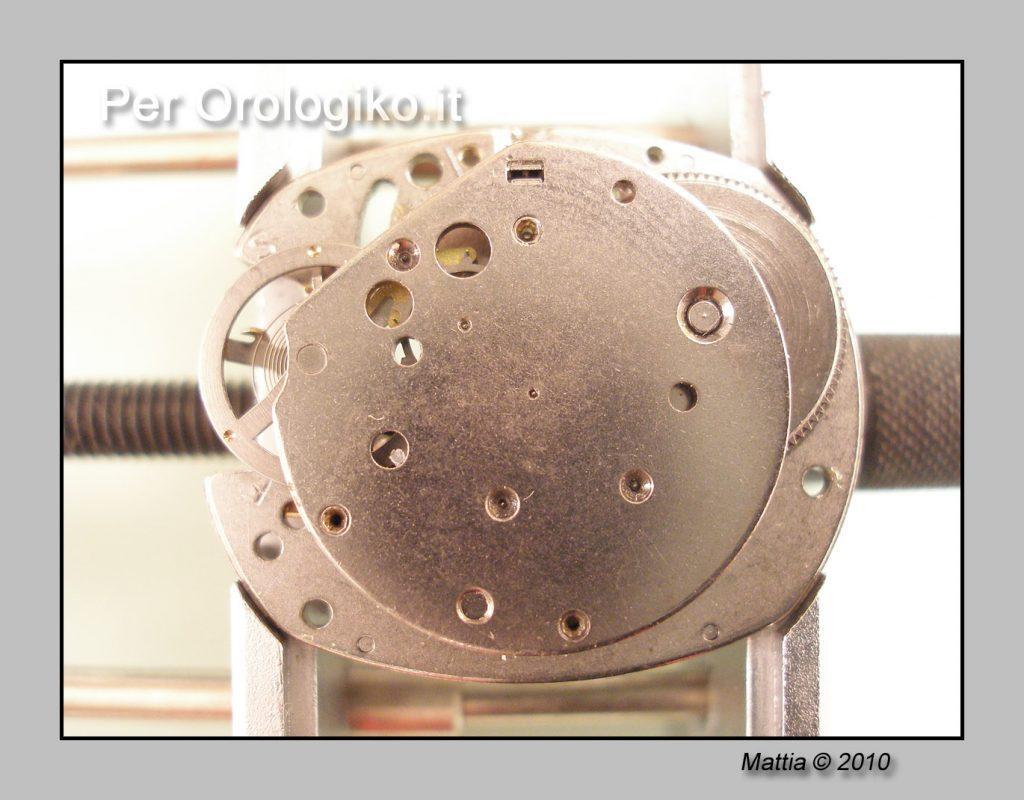
Now carefully pry with a screwdriver to remove what is now the upper platen. Normally it remains a little stuck in the shaft of the barrel, from the other parts it comes off effortlessly. Have you removed it? Well! What you see then is this: the heart!
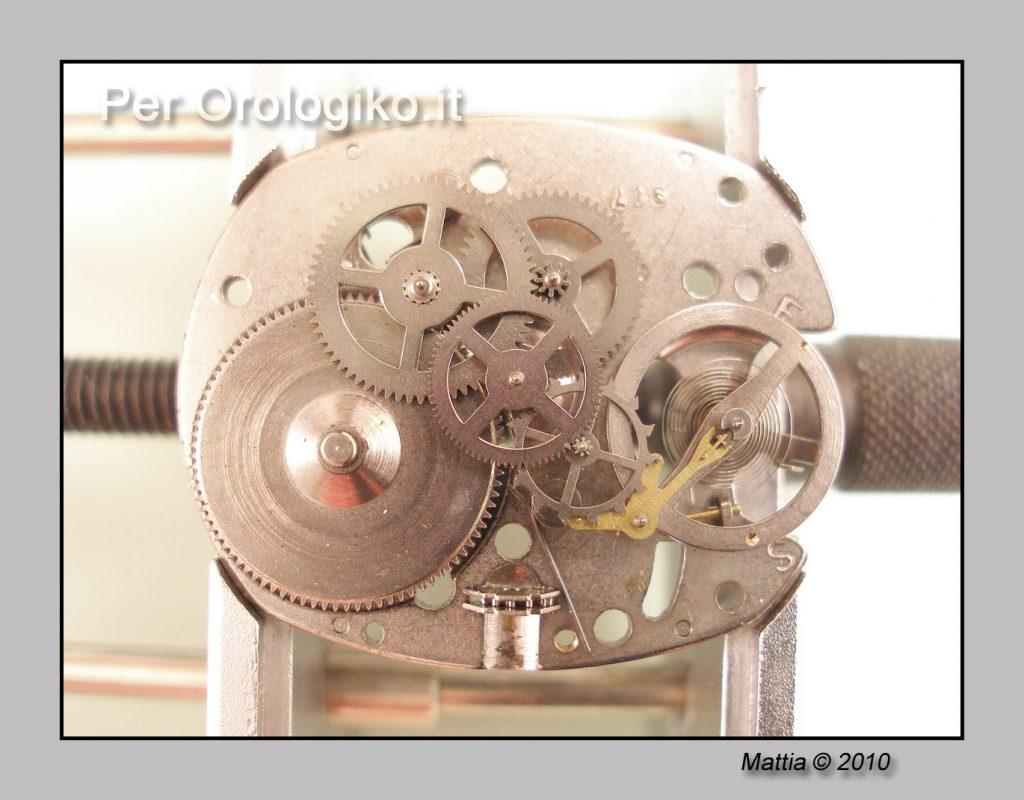
The photo above is essential during reassembly to put everything back in place without making mistakes and without forgetting a few pieces. Now we remove everything, always gently. Note only the small wheel where the winding shaft and its supports are inserted:
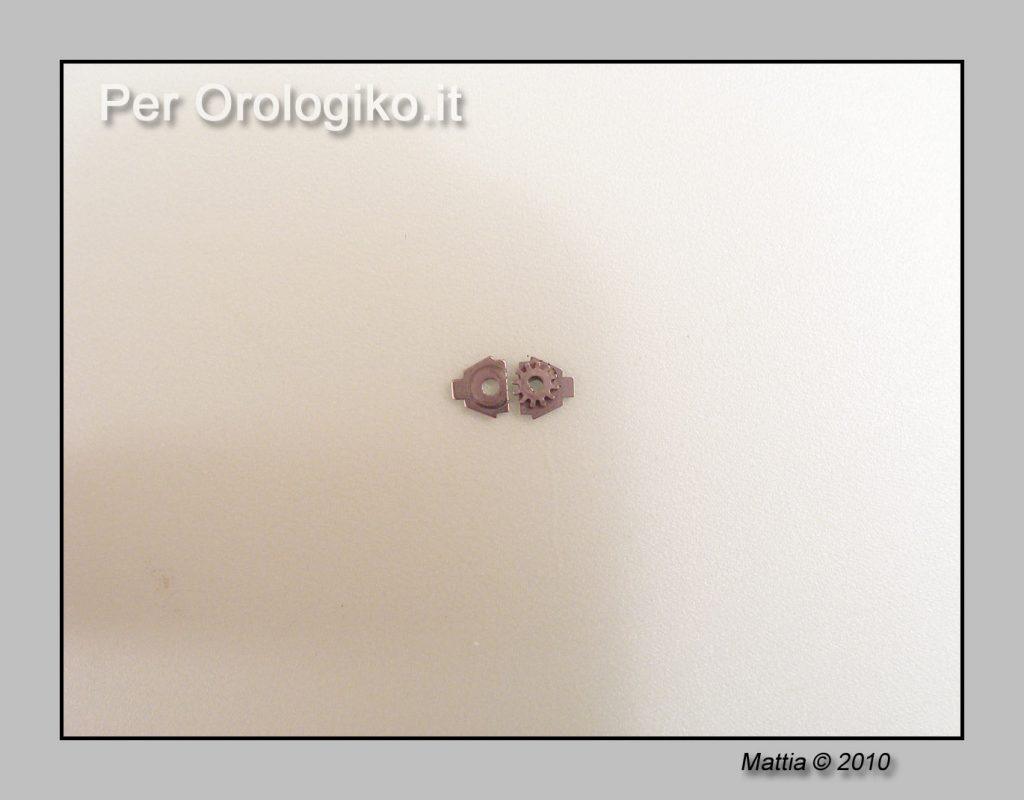
In the end we will find ourselves like this:

And here are the pieces:
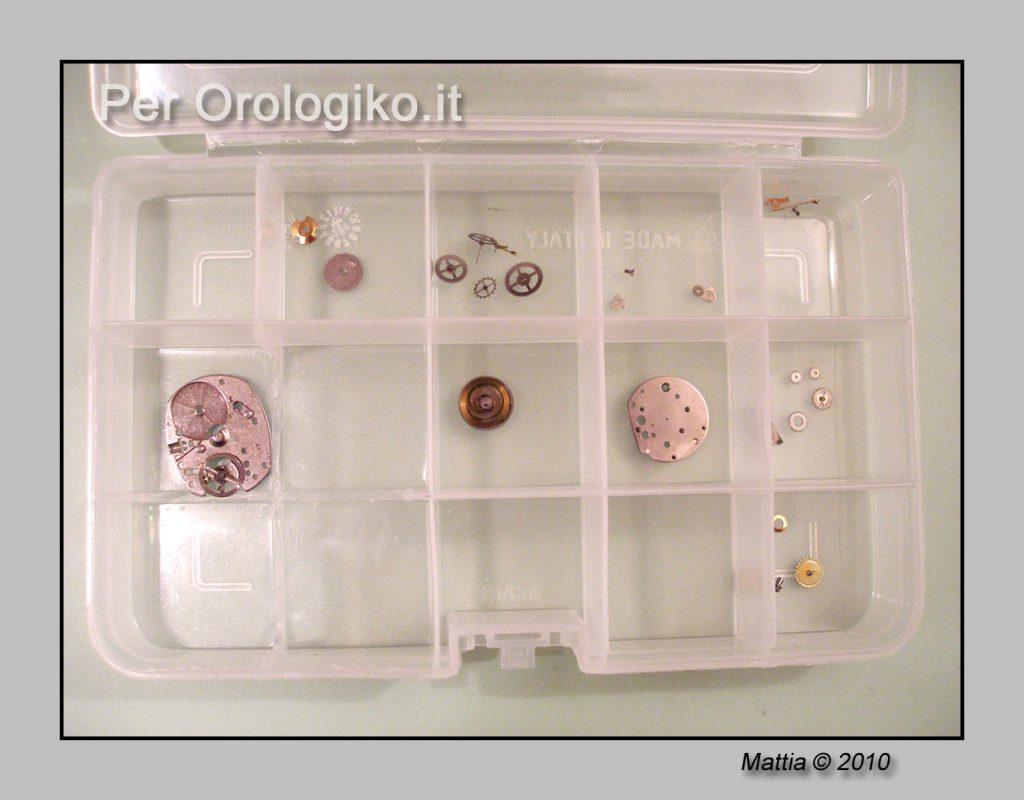
Have you noticed how many there are? There are very few and consider that this is a movement with a date window !! At this point, a nice ultrasound bath is a must to clean everything and start reassembly. I will not continue with the step by step even in the reassembly phase so as not to be more pedantic than I have already been, and then … just go backwards! Just a few VERY IMPORTANT considerations. The “difficult” part, which is not difficult, comes right now, in the reassembly phase (of course!). Let’s say that after this phase the rest is a game. I advise you to start reassembling the movement in a moment of calm when you unplug phones and mobile phones and you have no one around. Relaxing music, preventive stretching of the muscles of the arms and hands, before starting repeat the following mantra for 10 minutes: “I am calm and relaxed and I am omnipotent”, “I am calm and relaxed and I am omnipotent”, “I am calm and relaxed and I am omnipotent “… At this point I will reveal that the difficult part is to correctly reposition all the pieces on the plate (a nice secret, huh!). The biggest problems derive from the exhaust – balance wheel group where it happens that if you move one, two others move. This can take anywhere from two minutes (in this case you are either very good or very lucky) to twenty minutes (or clumsy or unlucky).
ATTENTION:
before closing the two sinkers it is necessary to oil in four points. Remember this or you will have to reopen … The points are:
1) the holes on the two sinkers where the barrel axis will be positioned, red arrows;
2) the two “recesses” (in fact they are not through holes, otherwise we would have oiled them with closed sinkers) where the balance wheel axis will be positioned, yellow arrows.

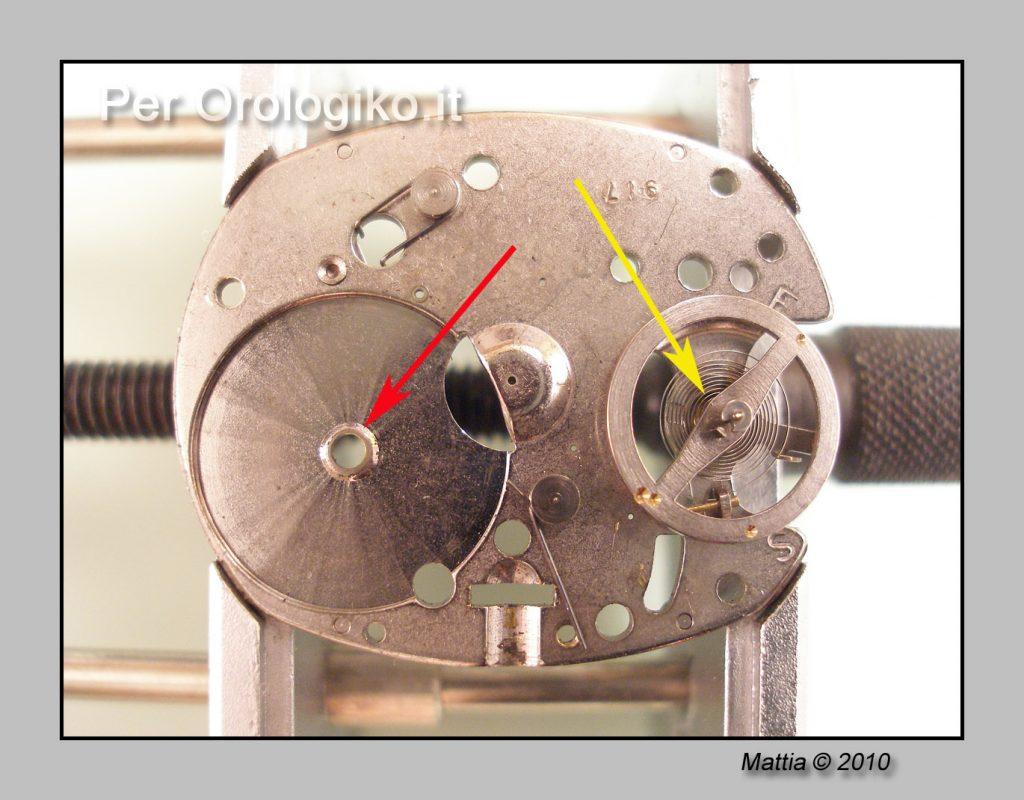
ATTENTION: the clip indicated by the arrow must be positioned as in the photo, on the right and not on the left (you would do it in any case because otherwise the other side annoys the insertion of the axes, but you never know!).
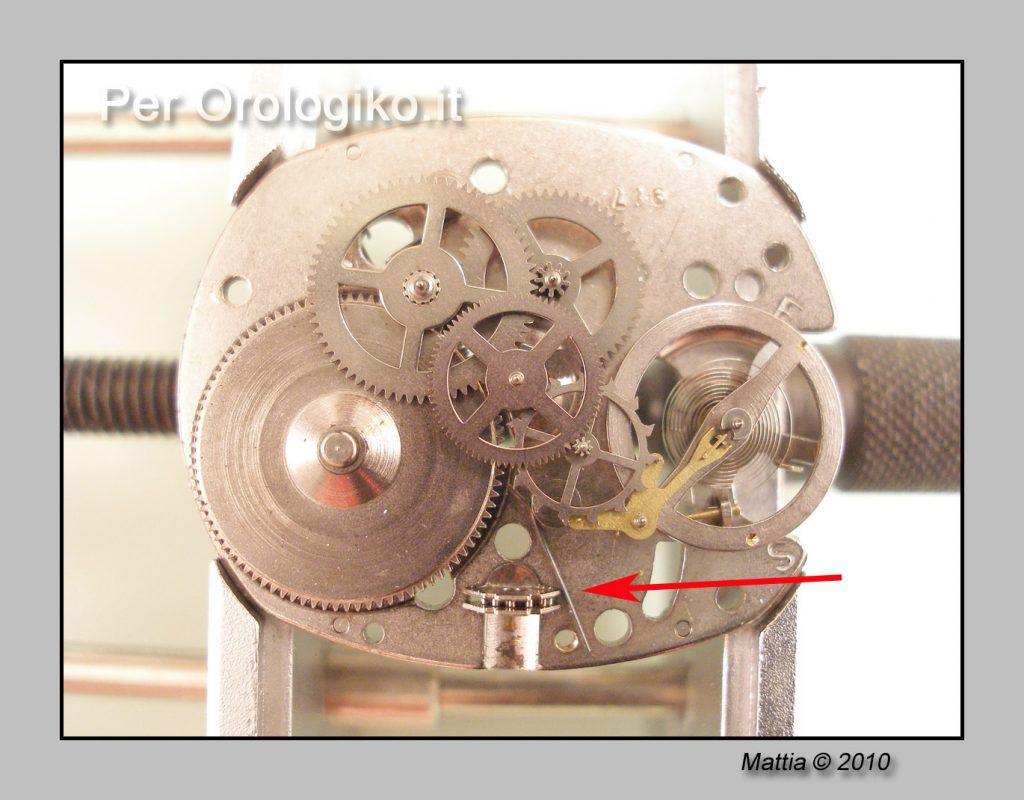
points and correctly positioned all the pieces, paying particular attention to the ankles correctly positioned against the escape wheel, gently rest the upper plate. If everything is in order the boards will almost immediately go into their holes. If this does not happen, a careful examination of the movement will certainly lead to understanding which axis does not enter and to remedy it. Calm and patience, calm and patience, we are all powerful, remember? The secret is just this, there is nothing, really nothing, difficult! At this point we play the game as before: remove the movement from the movement holder by keeping the two plates closed with your fingers and insert this screw:
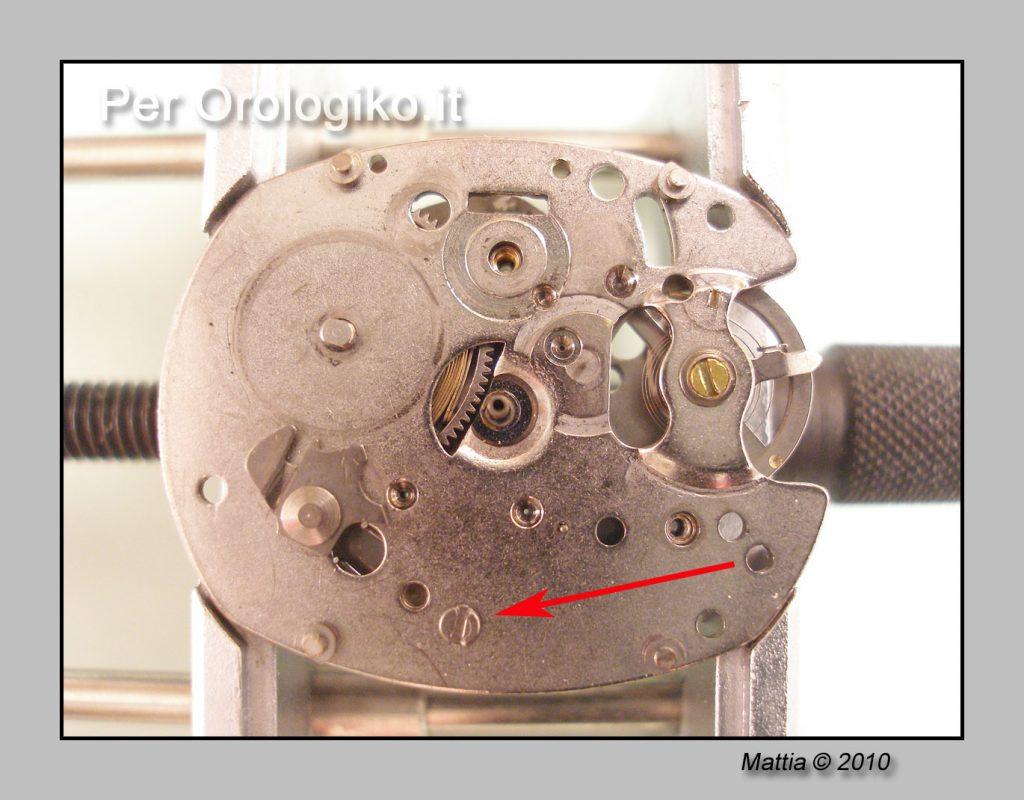
At this point the two sinkers, even with only one screw, remain closed and the rest … is child’s play !! One last recommendation: the clip indicated by the arrow, once the dancer is reinserted, must be positioned as it is in the picture and not on the other side!

As for the lubrication I acted as if it were a “normal” watch with rubies … a little bit of 9010 here, a little bit of 9020 there, the D5 for metal to metal, a little fat up there, the lubrication of the ankles with 941… in short, nothing different from the usual!
Oiling a vintage Timex watch
Before putting the dial back on your newly cleaned vintage Timex watch be sure to lightly oil all of the pivot points and moving parts on the watch. These have been circled below.
